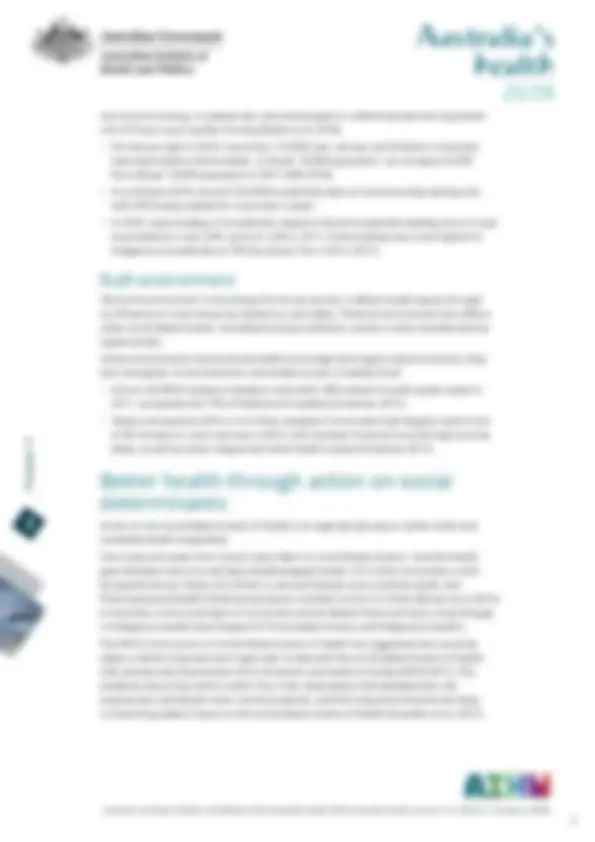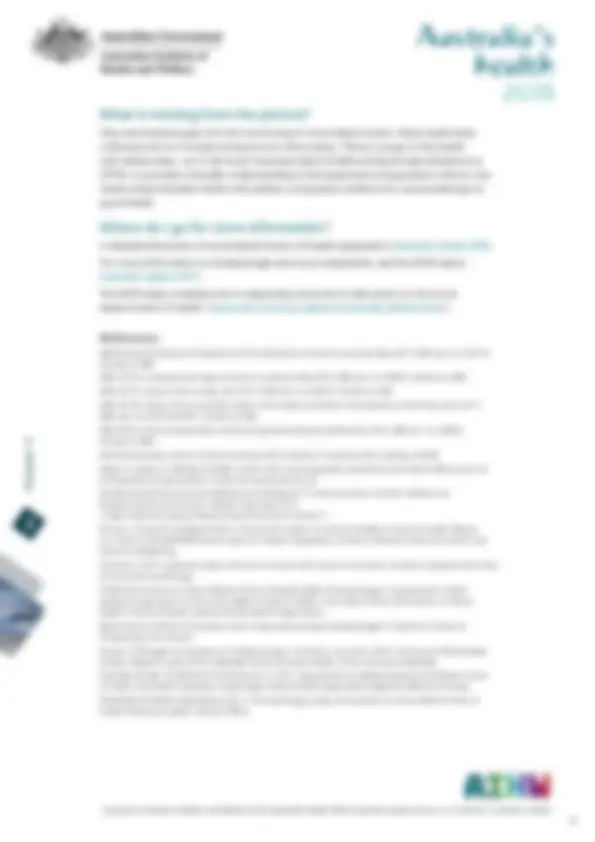




Study with the several resources on Docsity

Earn points by helping other students or get them with a premium plan


Prepare for your exams
Study with the several resources on Docsity

Earn points to download
Earn points by helping other students or get them with a premium plan
Community
Ask the community for help and clear up your study doubts
Discover the best universities in your country according to Docsity users
Free resources
Download our free guides on studying techniques, anxiety management strategies, and thesis advice from Docsity tutors
This document from the australian institute of health and welfare explores the social determinants of health in australia, focusing on social inequalities and disadvantage. It discusses the relationship between living and working conditions, socioeconomic position, and health outcomes. The document also covers topics such as early life, social exclusion, employment, housing, and urban environments. It provides statistics on various social determinants and their impact on health, highlighting disparities between different groups in society.
What you will learn
Typology: Study Guides, Projects, Research
1 / 4

This page cannot be seen from the preview
Don't miss anything!



Australian Institute of Health and Welfare 2018. Australia’s health 2018. Australia’s health series no. 16. AUS 221. Canberra: AIHW.
Chapter 4
Evidence supports the close relationship between people’s health and the living and working conditions which form their social environment. Factors such as socioeconomic position, conditions of employment, power and social support—known collectively as the social determinants of health—act together to strengthen or undermine the health of individuals and communities. The World Health Organization (WHO) describes social determinants as: …the circumstances in which people grow, live, work, and age, and the systems put in place to deal with illness. The conditions in which people live and die are, in turn, shaped by political, social, and economic forces (CSDH 2008). According to the WHO, social inequalities and disadvantage are the main reason for unfair and avoidable differences in health outcomes and life expectancy across groups in society. In 2015, the all-cause mortality rate for people in the lowest socioeconomic group was 1.5 times as high as for people in the highest socioeconomic group (see Chapter 5. ‘Socioeconomic groups’). This is reflected in life expectancy gaps. In 2011, Australian males and females in the lowest socioeconomic group lived, on average, 5.7 and 3.3 years less than males and females in the highest socioeconomic group. This snapshot provides a brief overview of some of the key social determinants of health in Australia.
Socioeconomic position can be described by indicators such as educational attainment, income or occupation. In general, every step up the socioeconomic ladder is accompanied by a benefit for health. The relationship is two-way—poor health can be both a product of, and contribute to, lower socioeconomic position (see Chapter 5.1 ‘Socioeconomic groups’).
The foundations of adult health are laid in-utero and during the perinatal and early childhood periods. The different domains of early childhood development—physical, social/emotional and language/cognition—strongly influence school success, economic participation, social citizenship and health.
2018 health Australian Institute of Health and Welfare 2018. Australia’s health 2018. Australia’s health series no. 16. AUS 221. Canberra: AIHW. 4 Chapter 4
Social exclusion is a term that describes social disadvantage and lack of resources, opportunity, participation and skills (McLachlan et al. 2013) (see Glossary). Social exclusion through discrimination or stigmatisation can cause psychological damage and harm health through long-term stress and anxiety. Poor health can also lead to social exclusion.
The psychosocial stress caused by unemployment has a strong impact on physical and mental health and wellbeing. Once employed, participating in quality work helps to protect health, instilling self-esteem and a positive sense of identity, while providing the opportunity for social interaction and personal development.
Access to appropriate, affordable and secure housing can limit the risk of Australians being socially excluded by factors such as homelessness, overcrowding and poor physical and mental health. Poor-quality housing influences physical and mental health. Young people, Indigenous Australians, people with long-term health conditions or disability, people living in
2018 health Australian Institute of Health and Welfare 2018. Australia’s health 2018. Australia’s health series no. 16. AUS 221. Canberra: AIHW. 4 Chapter 4
Data and analysis gaps limit the monitoring of social determinants. Many health data collections do not include socioeconomic information. There is scope to link health and welfare data—as in the South Australian Early Childhood Data Project (Nuske et al. 2016)—to provide a broader understanding of the experience of population cohorts, the relationships between health and welfare, and greater evidence for causal pathways to good health.
A detailed discussion of social determinants of health appeared in Australia’s health 2016. For more information on disadvantage and social inequalities, see the AIHW report Australia’s welfare 2017. The WHO plays a leading role in supporting countries to take action on the social determinants of health: <www.who.int/social_determinants/sdh_definition/en>.
ABS (Australian Bureau of Statistics) 2017a. Education and work, Australia, May 2017. ABS cat. no. 6227.0. Canberra: ABS. ABS 2017b. Employee earnings and hours, Australia, May 2016. ABS cat. no. 6306.0. Canberra: ABS. ABS 2017c. Labour force survey, April 2017. ABS cat. no. 6202.0. Canberra: ABS. ABS 2017d. Labour force, Australia: labour force status and other characteristics of families, June 2017. ABS cat. no. 6224.0.55.001. Canberra: ABS. ABS 2018. Census of population and housing: estimating homelessness, 2016. ABS cat. no. 2049.0. Canberra: ABS. ACOSS (Australian Council of Social Service) 2016. Poverty in Australia 2016. Sydney: ACOSS. Baker E, Lester LH, Bentley R & Beer A 2016. Poor housing quality: prevalence and health effects. Journal of Prevention & Intervention in the Community 44:219–32. Brotherhood of St Laurence & Melbourne Institute 2017. Social exclusion monitor. Melbourne: Brotherhood of St Laurence. Viewed 19 January 2017, https://www.bsl.org.au/research/social-exclusion-monitor/. Brown L, Thurecht L & Nepal B 2012. The cost of inaction on the social determinants of health. Report no. 2/2012: CHA-NATSEM second report on health inequalities. Canberra: National Centre for Social and Economic Modelling. Coleman S 2017. Australia: state of the environment 2016: built environment. Canberra: Department of the Environment and Energy. CSDH (Commission on Social Determinants of Health) 2008. Closing the gap in a generation: health equity through action on the social determinants of health. Final report of the Commission on Social Determinants of Health. Geneva: World Health Organization. McLachlan R, Gilfillan G & Gordon J 2013. Deep and persistent disadvantage in Australia. Canberra: Productivity Commission. Nuske T, Pilkington R, Gialamas A, Chittleborough C, Smithers L & Lynch J 2016. The early childhood data project. Research series 2016. Adelaide: School of Public Health, The University of Adelaide. Saunders M, Barr B, McHale P & Hamelmann C 2017. Key policies for addressing the social determinants of health and health inequities. Copenhagen: World Health Organization Regional Office for Europe. WHO (World Health Organization) 2011. Closing the gap: policy into practice on social determinants of health: discussion paper. Geneva: WHO.